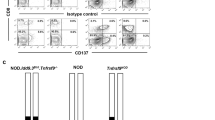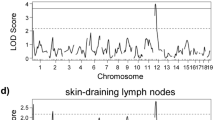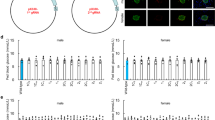Abstract
Penetrance of the complex of genes predisposing the nonobese diabetic (NOD) mouse to autoimmune diabetes is affected by the maternal environment. NOD.CBALs-Tyr+/Lt is an agouti-pigmented Chromosome 7 congenic stock of NOD/Lt mice produced as a resource for embryo transfer experiments to provide the necessary maternal factors and allow the easy identification of NOD (albino) embryo donor phenotype. CBcNO6/Lt, a recombinant congenic agouti stock already containing approximately 50% NOD genome, was used as the donor source of a wild-type CBA tyrosinase allele. When the incidence of diabetes was assessed after nine generations of backcrossing and one generation of sib-sib mating, significant reduction in diabetes development was observed. No difference in diabetes development was observed in Tyr/Tyrc heterozygotes, showing that protection was recessive. Analysis of diabetes progression in another NOD stock congenic for C57BL/6 alleles on Chromosome 7 linked to the glucose phosphate isomerase (Gpi1b) locus provided no protection, indicating that the diabetes resistance (Idd) gene was distal to 34 cM (D7Mit346). Approximately 5 cM of the distal congenic region overlaps a region from C57L previously associated with protection when homozygous. The delayed onset and reduced frequency of diabetes in the NOD.CBALs-Tyr+/Lt stock is an advantage when females of this stock are used as surrogate mothers in studies involving hysterectomy or embryo transfers. Indeed, a newly developed NOD embryonic stem (ES) cell line injected into NOD.CBALs- Tyr+/Lt blastocysts produced approximately 50% live-born mice, of which approximately 11% were chimeric. Presumably because of high genomic instability, no germline transmission was observed.




Similar content being viewed by others
References
Ablamunits V, Bridgett M, Duffy T, Nissen M, Haag F, et al. (2001) Changing patterns of T cell surface mono (ADP-Ribosyltransferase) antigen ART2.2 on resting versus cytopathically activated T cells in NOD/Lt mice. Diabetologia 44: 848–858
Arai S, Minjares C, Nagafuchi S, Miyazaki T (2004) Improved experimental procedures for achieving efficient germ line transmission of nonobese diabetic (NOD)-derived embryonic stem cells. Exp Diabesity Res 5: 219–226
Baxter AG, Cooke A (1993) Complement lytic activity has no role in the pathogenesis of autoimmune diabetes in NOD mice. Diabetes 42: 1574–1578
Bortell R, Kanaitsuka T, Stevens L A, Moss J, Mordes J P, et al. (1999) The RT6 (Art2) family of ADP-ribosyltransferases in rat and mouse. Mol Cell Biochem 193: 61–68
Brook FA, Evans EP, Lord CJ, Lyons PA, Rainbow DB, et al. (2003) The derivation of highly germline-competent embryonic stem cells containing NOD-derived genome. Diabetes 52: 205–208
Gerling IC, Serreze DV, Christianson SW, Leiter EH (1992) Intrathymic islet cell transplantation reduces beta cell autoimmunity and prevents diabetes in NOD/Lt mice. Diabetes 41: 1672–1676
Ghosh S, Palmer SM, Rodrigues NR, Cordell HJ, Hearne CM, et al. (1993) Polygenic control of autoimmune diabetes in nonobese diabetic mice. Nat Genet 4: 404–409
Greeley SA, Katsumata M, Yu L, Eisenbarth GS, Moore DJ, et al. (2002) Elimination of maternally transmitted autoantibodies prevents diabetes in nonobese diabetic mice. Nat Med 8: 399–402
Hall RJ, Hollis-Moffatt JE, Merriman ME, Green RA, Baker D, et al. (2003) An autoimmune diabetes locus (Idd21) on mouse Chromosome 18. Mamm Genome 14: 335–339
Haskins K, Kench J, Powers K, Bradley B, Pugazhenthi S, et al. (2004) Role for oxidative stress in the regeneration of islet beta cells? J Invest Med 52: 45–49
Kahl S, Nissen M, Girisch R, Duffy T, Leiter E H, et al. (2000) Metalloprotease-mediated shedding of enzymically active mouse ecto ADP-ribosyltransferase ART2.2 upon T cell activation. J Immunol 165: 4463–4469
Kawamura H, Aswad F, Minagawa M, Malone K, Kaslow H, et al. (2005) P2X7 receptor-dependent and -independent t cell death is induced by nicotinamide adenine dinucleotide. J Immunol 174: 1971–1979
Koch-Nolte F, Duffy T, Nissen M, Kahl S, Killen N, et al. (1999) New monoclonal antibody detects a developmentally regulated mouse ecto-ADP-ribosyltransferase on T cells: subset distribution, inbred strain variation, and modulation by T cell activation. J Immunol 163: 6014–6022
Koch-Nolte F, Abromeit M, Gerber A, Kahl S, Ohlrogge W, et al. (2000) Molecular characterization of a family of NAD+ metabolizing ectoenzymes in mice and men: endogenous relatives of ADP-ribosylating bacterial toxins. In Ecto-ATPases, Related Ectonucleotidases, Van Duffel L, Lemmens R, eds. (Maastricht: Shaker Publishing), pp 221–233
Leiter EH (2002) Mice with targeted gene disruptions or gene insertions for diabetes research: problems, pitfalls, and potential solutions. Diabetologia 45: 296–308
Mathews CE, Graser RT, Savinov A, Serreze DV, Leiter EH (2001) Unusual resistance of ALR/Lt mouse beta cells to autoimmune destruction: role for beta cellexpressed resistance determinants. Proc Natl Acad Sci U S A 98: 235–240
Mathews CE, Graser RT, Bagley RJ, Caldwell JW, Li R, et al. (2003) Genetic analysis of resistance to type 1 diabetes in ALR/Lt mice, a NOD-related strain with defenses against autoimmune-mediated diabetogenic stress. Immunogenetics 55: 491–496
McAleer MA, Reifsnyder P, Palmer SM, Prochazka M, Love JM, et al. (1995) Crosses of NOD mice with the related NON strain: a polygenic model for type I diabetes. Diabetes 44: 1186–1195
McDuffie M, (2000) Derivation of diabetes-resistant congenic lines from the nonobese diabetic mouse. Clin Immunol 96: 119–130
Melanitou E, Devendra D, Liu E, Miao D, Eisenbarth GS (2004) Early and quantal (by litter) expression of insulin autoantibodies in the nonobese diabetic mice predict early diabetes onset. J Immunol 173: 6603–6610
Nagafuchi S, Katsuta H, Kogawa K, Akashi T, Kondo S, et al. (1999) Establishment of an embryonic stem (ES) cell line derived from a non-obese diabetic (NOD) mouse: in vivo differentiation into lymphocytes and potential for germ line transmission. FEBS Lett 455: 101–104
Nagy A, Gertsenstein M, Vintersten K, Behringer R (2003) Manipulating the Mouse Embryo, A Laboratory Manual. (Cold Spring Harbor, NY: Cold Spring Harbor Laboratory Press)
Reifsnyder PC, Flynn JC, Gavin AL, Simone EA, Sharp JJ, et al. (1999) Genotypic and phenotypic characterization of six new recombinant congenic strains derived from NOD/Shi and CBA/J genomes. Mamm Genome 10: 161–167
Seman M, Adriouch S, Haag F, Koch-Nolte F (2004) Ecto-ADP-ribosyltransferases (ARTs): emerging actors in cell communication and signaling. Curr Med Chem 11: 857–872
Serreze DV, Leiter EH (2001) Genes and cellular requirements for autoimmune diabetes susceptibility in nonobese diabetic mice. Curr Dir Autoimmun 4: 31–67
West JD, Fisher G (1984) A new allele of the Gpi-1t temporal gene that regulates the expression of glucose phosphate isomerase in mouse oocytes. Genet Res 44: 169–181
Acknowledgments
The authors gratefully acknowledge the assistance provided by Pamela Stanley, Bruce Regimbal, and Steve Langley for animal breeding, and Evie Sargent for allelic phenotyping of Hc. They thank Charles Lerner of The Jackson Laboratory for maintaining the NOD ES cells from the University of Toronto and Ms. April Lee for performing the blastocoele injections. This work was supported by NIH grants DK27722 and DK36175 (EHL), German Research Foundation grant DFG No310/7 (FKN), and Juvenile Diabetes Foundation International grant 41998-172 (AN, HMD, JE). Institutional shared services were supported by National Cancer Institute Center Support Grant CA34196.
Author information
Authors and Affiliations
Corresponding author
Rights and permissions
About this article
Cite this article
Chen, J., Reifsnyder, P.C., Scheuplein, F. et al. “Agouti NOD”: identification of a CBA-derived Idd locus on Chromosome 7 and its use for chimera production with NOD embryonic stem cells. Mamm Genome 16, 775–783 (2005). https://doi.org/10.1007/s00335-005-0007-1
Received:
Accepted:
Published:
Issue Date:
DOI: https://doi.org/10.1007/s00335-005-0007-1




